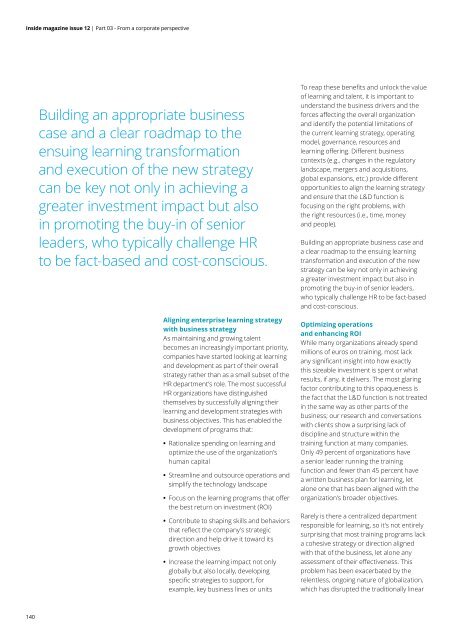lu_inside12-full
Create successful ePaper yourself
Turn your PDF publications into a flip-book with our unique Google optimized e-Paper software.
Inside magazine issue 12 | Part 03 - From a corporate perspective<br />
Building an appropriate business<br />
case and a clear roadmap to the<br />
ensuing learning transformation<br />
and execution of the new strategy<br />
can be key not only in achieving a<br />
greater investment impact but also<br />
in promoting the buy-in of senior<br />
leaders, who typically challenge HR<br />
to be fact-based and cost-conscious.<br />
Aligning enterprise learning strategy<br />
with business strategy<br />
As maintaining and growing talent<br />
becomes an increasingly important priority,<br />
companies have started looking at learning<br />
and development as part of their overall<br />
strategy rather than as a small subset of the<br />
HR department’s role. The most successful<br />
HR organizations have distinguished<br />
themselves by success<strong>full</strong>y aligning their<br />
learning and development strategies with<br />
business objectives. This has enabled the<br />
development of programs that:<br />
••<br />
Rationalize spending on learning and<br />
optimize the use of the organization’s<br />
human capital<br />
••<br />
Streamline and outsource operations and<br />
simplify the technology landscape<br />
••<br />
Focus on the learning programs that offer<br />
the best return on investment (ROI)<br />
••<br />
Contribute to shaping skills and behaviors<br />
that reflect the company’s strategic<br />
direction and help drive it toward its<br />
growth objectives<br />
••<br />
Increase the learning impact not only<br />
globally but also locally, developing<br />
specific strategies to support, for<br />
example, key business lines or units<br />
To reap these benefits and unlock the va<strong>lu</strong>e<br />
of learning and talent, it is important to<br />
understand the business drivers and the<br />
forces affecting the overall organization<br />
and identify the potential limitations of<br />
the current learning strategy, operating<br />
model, governance, resources and<br />
learning offering. Different business<br />
contexts (e.g., changes in the regulatory<br />
landscape, mergers and acquisitions,<br />
global expansions, etc.) provide different<br />
opportunities to align the learning strategy<br />
and ensure that the L&D function is<br />
focusing on the right problems, with<br />
the right resources (i.e., time, money<br />
and people).<br />
Building an appropriate business case and<br />
a clear roadmap to the ensuing learning<br />
transformation and execution of the new<br />
strategy can be key not only in achieving<br />
a greater investment impact but also in<br />
promoting the buy-in of senior leaders,<br />
who typically challenge HR to be fact-based<br />
and cost-conscious.<br />
Optimizing operations<br />
and enhancing ROI<br />
While many organizations already spend<br />
millions of euros on training, most lack<br />
any significant insight into how exactly<br />
this sizeable investment is spent or what<br />
results, if any, it delivers. The most glaring<br />
factor contributing to this opaqueness is<br />
the fact that the L&D function is not treated<br />
in the same way as other parts of the<br />
business; our research and conversations<br />
with clients show a surprising lack of<br />
discipline and structure within the<br />
training function at many companies.<br />
Only 49 percent of organizations have<br />
a senior leader running the training<br />
function and fewer than 45 percent have<br />
a written business plan for learning, let<br />
alone one that has been aligned with the<br />
organization’s broader objectives.<br />
Rarely is there a centralized department<br />
responsible for learning, so it’s not entirely<br />
surprising that most training programs lack<br />
a cohesive strategy or direction aligned<br />
with that of the business, let alone any<br />
assessment of their effectiveness. This<br />
problem has been exacerbated by the<br />
relentless, ongoing nature of globalization,<br />
which has disrupted the traditionally linear<br />
140


